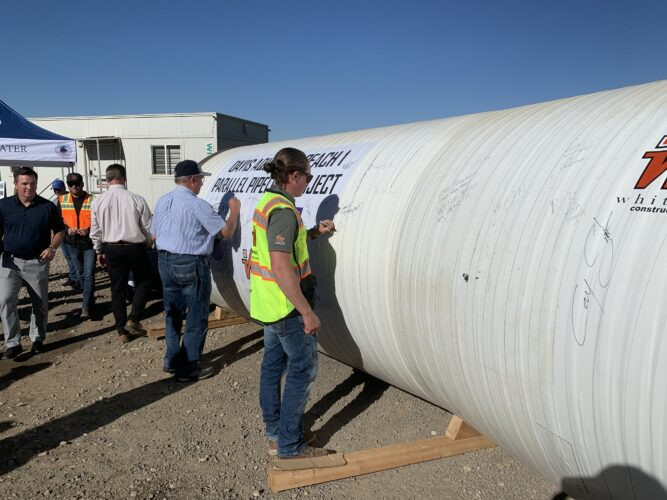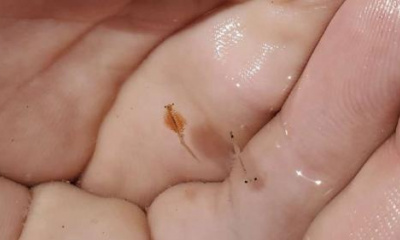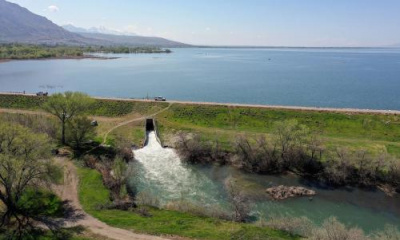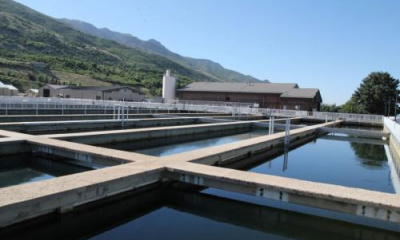SOUTH WEBER — The immense natural processes that have formed the Earth over billions of years haven’t come to a stop just because modern societies have had the opportunity to proliferate on its surface.
That is just as true along the Wasatch Front. However, an ongoing project looks to mitigate the impact of large earthquakes on water delivery to Weber and Davis counties.
On Wednesday, the Utah Division of Water Resources and the Weber Basin Water Conservancy District held a press conference at a pumping station near the mouth of the Weber Canyon that is part of an $81 million seismic resilience project for the Davis Aqueduct.
Joel Ferry, executive director of Utah Department of Natural Resources, opened the press conference by noting that everyone living along the Wasatch Front lives with an ominous reality hanging over their heads.
“We recognize we live in earthquake country,” he said. “Earthquakes are a common factor here on the Wasatch Front. Especially here — we are on the fault. … It’s not a question of, ‘Is an earthquake going to happen, if one is going to happen?’ It is, ‘When?’ So, when one happens — and there’s a high likelihood that one will happen — we need to be prepared and we need to be ready.”
One way officials are looking to do that is with what is officially called the Davis Aqueduct Reach 1 Parallel Pipeline.
“The Davis Aqueduct Reach 1 Parallel Pipeline construction project is the construction of a pipeline and associated appurtenances to increase the resiliency of the Davis Aqueduct,” the Weber Basin projects page reads. “The existing Davis Aqueduct was built in the mid 1950’s and currently serves large portions of Davis County. The new pipeline will provide a more reliable conveyance of water to Davis County as part of the Districts resiliency preparedness. The project is expected to be under construction for a 24-month period. It will include two new pump stations and approximately 2.2 miles of 72-inch diameter welded steel piping, part of which will include specially designed flexible seismic piping at a major fault line.”
The description adds, “the new pipeline will terminate at the North Davis Water Treatment Plant. The water will be used for both treated culinary water and secondary irrigation. The alignment of the pipeline will cross Highway 89 and run parallel to the west side of the highway.”
Whitaker Construction and several other subcontractors are working on the project, which will serve 650,000 people in Weber and Davis counties.
Scott Paxman, executive director of the Weber Basin Water Conservancy District, noted that this project puts the current water infrastructure’s age in perspective.
“An $81 million project — that was the amount of money that it took to build the entire Weber Basin project, including all the dams, reservoirs, pipelines, canals, pump stations back in the 1950s,” he said.
Following the press conference, Ferry told the Standard-Examiner that the project came about following the March 18, 2020, earthquake.
“It was a real eye-opener to what could happen,” he said. “Hundreds of buildings were damaged and that was just a 5.7. We’re anticipated to have one magnitude bigger within the next 50 years. We have a greater than 50% chance. So when that happens, you have some of this infrastructure that’s old and built 50, 80, 100 years ago — back when there was different techniques and different materials they could build with. The aqueduct today is a cement pipeline when, if there’s any shift in the ground, it will fracture. It will break. This aqueduct that we’re talking about today crosses that fault line five different times.”
He said advanced construction of the new pipeline mitigates those risks.
“We are using advanced building materials that will not rupture in an earthquake,” he said. “They will be flexible. They will move. You will not see a disruption to the same level. You’ll see water continue to flow to people’s homes and businesses to support life in the likely event that we have a big earthquake.”
Paxman said the new pipeline could withstand around a magnitude 7.5 earthquake.
“The pipeline is designed for a 7-foot vertical sheer,” he said. “It’s 1-inch thick welded steel. It’ll be up in the air somewhere, but it’ll still hold and transmit water for treatment.”
He said the first phase of the pipeline — which includes the initial 72-inch pipeline — will likely be completed in the fall of 2025.
“The final phase is to put a second 72-inch pipeline parallel to that one,” he said. “That one, we’re anticipating anywhere between 8-10 years in the future to complete that. Then we’ll eventually abandon the 84-inch original aqueduct that’s on the fault line.”
Ferry said this isn’t the only place along the Wasatch Front that is vulnerable and work is underway to rectify other potential problem areas.
“There’s over half-a-billion dollars of need to make our aqueduct systems resilient to earthquakes,” he said. “Here in Weber and Davis County, Salt Lake County going down to Utah County all have huge vulnerabilities. … Two years ago, the state funded a $50 million grant program to supplement the water districts. The water districts are paying the majority of the cost. The overall cost is $540 million. The state’s putting in 10% and the districts are going out and getting federal money, but a lot of it’s coming from user fees from property tax.”
He said hopes are to have all of the water systems along the Wasatch Front resilient to earthquakes within the decade.
Additional speakers at Wednesday’s press conference included Utah state legislator Casey Snider, Layton Mayor Joy Petro and Candice Hasenyager, director of the Utah Division of Water Resources.
Following the press conference, stakeholders were invited to sign part of the pipeline that will be utilized in the project and were given the opportunity to tour the pump house.








